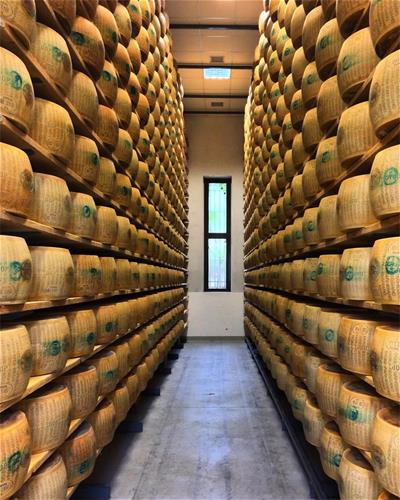All chunks of Parmigiano Reggiano aren’t created equal—but you wouldn’t know that by looking at them. One 80-pound wheel of Parmesan looks pretty much like another. But there can be a world of difference in flavor between Parmesans made by different dairies. They’re all going to be good—but only a few are fantastic.
This wheel of Parmigiano Reggiano is not the same as that one.
Today, there are 339 dairies that make Parmigiano Reggiano cheese. Parmigiano Reggiano is protected by a DOP, which translates in English to Protected Designation of Origin. That means that legally, to be called Parmigiano Reggiano, all wheels must meet certain standards. The 339 dairies are all located in northern Italy in and around the districts of Parma, Reggio-Emilia, Modena and parts of Mantua and Bologna. The milk they use must all come from cows that live in those areas. They all use the same basic recipe, right down to all making their cheese in giant copper kettles.
However, the DOP only defines so much. Between those 339 dairies, there can be a lot of variation. The milk can come from different breeds of cows that can live at different elevations. Those cows can be fed different grasses and grains that were grown with different methods. The cheesemaker can choose to tweak the levels of butterfat or salt or cultures they add to the milk. The wheels can be aged at warmer or cooler temperatures. They can be sold as young as 13 months or aged for half a decade or more. Each of those variations will impact the final quality and flavor of the cheese. But the label may not list any of these differences: they’re all just called Parmigiano Reggiano.
So then how do you know the difference between them?
I wish I had a clean, simple rule I could give you to easily distinguish between good Parmesan and great Parmesan, but there’s not a quick reference that makes everything clear. The best advice I can offer is to taste a lot, and when possible, to learn more about the story behind a particular wheel of Parmigiano Reggiano: where exactly it comes from, who makes it, and what’s unique about what they’re doing.
A good example is Giorgio Cravero’s selection of Parmigiano Reggiano. Giorgio isn’t a cheesemaker. His family has been selecting and aging cheeses in the town of Bra for five generations, since 1855. While Giorgio isn’t the one producing the cheese, he has very close relationships with the cheesemakers.
For the cheese we sell, he selects his wheels of Parmigiano Reggiano from a dairy called San Pietro. They’re located in a village called Benedello di Pavullo, situated over 700 meters (or 2,300 feet) above sea level. At that high elevation, there’s a lot more diversity in the grasses, including plenty of wildflowers and herbs. Compared to the lowland valleys with the lush but uniform grasses that most of the Parmesan cows eat, the greater variation in the forage makes for more interesting, more flavorful milk. The San Pietro cheesemakers use their milk to make a total of six wheels each day, for a grand total of just about 2,200 wheels of cheese per year.
When the wheels are 12 months old, Giorgio collects them from the dairy and brings them to his aging cave in Bra. There, the cheeses age at cool, ambient temperatures. That allows the cheese to mature slowly. Giorgio and his team also flip the wheels over more frequently than at most cheese caves. The low temperatures and frequent flipping help to keep the cheeses moist. While some Parmigiano Reggianos can be quite hard, Cravero Parmesan tends to have a slightly softer, more creamy texture (though it’s still a hard cheese). The slow aging also helps develop a sweet, delicate flavor. And unlike most Parmesan makers and agers who only taste the cheese if they suspect there’s a problem, Giorgio regularly tastes his Parmigiano Reggiano to ensure it has those soft, sweet notes he prefers.
Different Parmesans, different uses.
The fact that there are differences between Parmesans doesn’t mean we need to find the one “best” one. Just like you might choose to buy one wine to go with steak, a different wine to go with fish, and a third wine to go with a creamy dessert, you might choose a different Parmesan based on what you wanted to use it for. And while you could certainly grate Cravero Parmesan over a plate of pasta (and it would be very good—in fact, it’s one of Giorgio’s favorite lunches), the sweet, almost cherry lusciousness of the cheese makes it a great choice for nibbling. Try carving off a few chunks for an after dinner snack with fruit like grapes or figs, or even with a nib of good dark chocolate.
Giorgio Cravero’s super favorite, eats-it-all-the-time lunch
Martelli spaghetti
Sea salt
Roi olive oil
Cravero Parmigiano Reggiano
1. Boil the spaghetti—about 2-4 ounces per person, depending on how hungry you feel—in heavily salted water. How much salt? Giorgio says, “A lot.” For every liter and a half of water, two handfuls of salt.
2. When you have cooked the pasta to a perfect al dente, with just a bit of chew left to it, drain the water from the pan—but don’t discard it. Instead, pour it in your pasta bowls to warm them.
3. Return the pasta to the empty pot. Add an Italian’s “reasonable portion” of Roi olive oil, which is probably two or three times what you and I consider reasonable. Add plenty of grated Cravero Parmigiano Reggiano and mix.
4. Empty the serving bowls of the warm water, put the pasta in them, dust with a second snow of Parmigiano Reggiano
5. Eat with a crisp red apple

